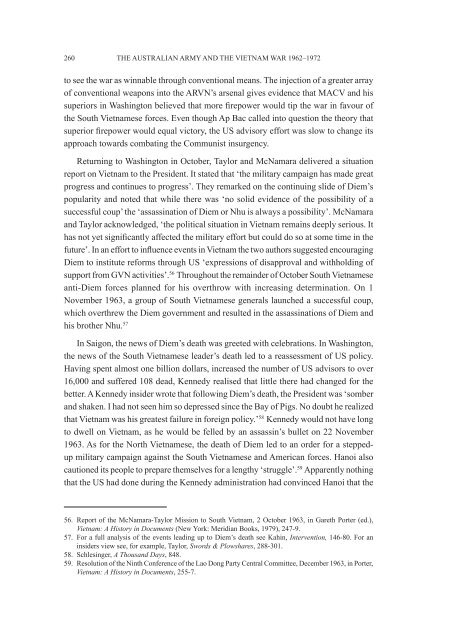conference proceedings - Australian Army
conference proceedings - Australian Army
conference proceedings - Australian Army
You also want an ePaper? Increase the reach of your titles
YUMPU automatically turns print PDFs into web optimized ePapers that Google loves.
260<br />
THE AUSTRALIAN ARMY AND THE VIETNAM WAR 1962–1972<br />
to see the war as winnable through conventional means. The injection of a greater array<br />
of conventional weapons into the ARVN’s arsenal gives evidence that MACV and his<br />
superiors in Washington believed that more firepower would tip the war in favour of<br />
the South Vietnamese forces. Even though Ap Bac called into question the theory that<br />
superior firepower would equal victory, the US advisory effort was slow to change its<br />
approach towards combating the Communist insurgency.<br />
Returning to Washington in october, Taylor and McNamara delivered a situation<br />
report on Vietnam to the President. It stated that ‘the military campaign has made great<br />
progress and continues to progress’. They remarked on the continuing slide of Diem’s<br />
popularity and noted that while there was ‘no solid evidence of the possibility of a<br />
successful coup’ the ‘assassination of Diem or Nhu is always a possibility’. McNamara<br />
and Taylor acknowledged, ‘the political situation in Vietnam remains deeply serious. It<br />
has not yet significantly affected the military effort but could do so at some time in the<br />
future’. In an effort to influence events in Vietnam the two authors suggested encouraging<br />
Diem to institute reforms through US ‘expressions of disapproval and withholding of<br />
support from GVN activities’. 56 Throughout the remainder of october South Vietnamese<br />
anti-Diem forces planned for his overthrow with increasing determination. on 1<br />
November 1963, a group of South Vietnamese generals launched a successful coup,<br />
which overthrew the Diem government and resulted in the assassinations of Diem and<br />
his brother Nhu. 57<br />
In Saigon, the news of Diem’s death was greeted with celebrations. In Washington,<br />
the news of the South Vietnamese leader’s death led to a reassessment of US policy.<br />
Having spent almost one billion dollars, increased the number of US advisors to over<br />
16,000 and suffered 108 dead, Kennedy realised that little there had changed for the<br />
better. A Kennedy insider wrote that following Diem’s death, the President was ‘somber<br />
and shaken. I had not seen him so depressed since the Bay of Pigs. No doubt he realized<br />
that Vietnam was his greatest failure in foreign policy.’ 58 Kennedy would not have long<br />
to dwell on Vietnam, as he would be felled by an assassin’s bullet on 22 November<br />
1963. As for the North Vietnamese, the death of Diem led to an order for a steppedup<br />
military campaign against the South Vietnamese and American forces. Hanoi also<br />
cautioned its people to prepare themselves for a lengthy ‘struggle’. 59 Apparently nothing<br />
that the US had done during the Kennedy administration had convinced Hanoi that the<br />
56. Report of the McNamara-Taylor Mission to South Vietnam, 2 october 1963, in Gareth Porter (ed.),<br />
Vietnam: A History in Documents (New York: Meridian Books, 1979), 247-9.<br />
57. For a full analysis of the events leading up to Diem’s death see Kahin, Intervention, 146-80. For an<br />
insiders view see, for example, Taylor, Swords & Plowshares, 288-301.<br />
58. Schlesinger, A Thousand Days, 848.<br />
59. Resolution of the Ninth Conference of the Lao Dong Party Central Committee, December 1963, in Porter,<br />
Vietnam: A History in Documents, 255-7.

















